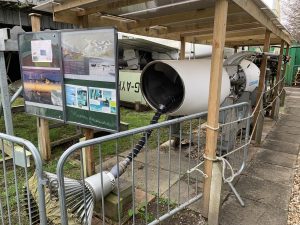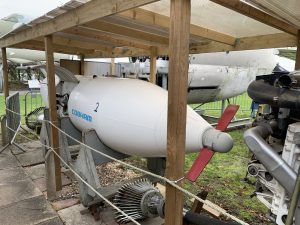Technical Data
Length:
Height:
Our Exhibit
Flight refuelling equipment
The system of in-flight refuelling (IFR) was perfected locally by a company called Flight Refuelling based at Tarrant Rushton airfield. The system enabled an aircraft’s range to be increased without the need to land en-route. It was tested in 1938-40 with Imperial Airways aircraft being refuelled for transatlantic services. In the late 1940’s Flight Refuelling developed a military system which was taken up by the US Air Force for use by bombers and fighters. The RAF were slower in accepting IFR – early trials involved a Meteor refuelling from an Avro Lincoln tanker. The impending introduction of V-Bombers in the late 1950’s saw the RAF finally accept the principle of IFR. On display here at the Museum is a Mark 17B HDU as fitted in Victor Tankers and a typical underwing pod.
Type History
Flight Refuelling developed a Hose and Drum Unit (HDU) in the early 1950’s which was fitted in the belly of the tanker aircraft – initially converted bombers. A fuel hose was coiled around a large drum which then fed out a hose which had a receptacle fitted on the end. The receiving aircraft – usually a bomber or fighter was fitted with a probe which the pilot skilfully aimed at the receptacle –later referred to as a basket. Once connected, fuel would pass from the tanker to the receiving aircraft, which would break away once it’s tanks had been filled.
In the time of the Cold War, Britain’s V-Bombers would be refuelled over the North Sea as they made their way to Russia. Fighters would be refuelled so they could remain longer over the North Sea, whilst they were waiting to intercept the Russian Badger and Bear bombers. Initially the RAF used Valiant bombers as tankers, replacing them in 1965 to using converted Victor bombers.
In order to make IFR more available, Flight Refuelling developed a smaller HDU fitted inside a pod, which could be carried under an aircraft’s wing. This was adopted by the Royal Navy where the pods were fitted under the wings of carrier borne fighters so they could refuel other fighters that were setting off on missions. In the 1960’s Scimitars and Sea Vixens were quickly converted into tankers in order to refuel other Sea Vixens or Buccaneers. The pods were also fitted to larger aircraft in order to make them multi-point refuellers. They were fitted under the wings of RAF VC10 (1984) and Tristar (1986) tankers in addition the normal HDU fitted under the fuselage. This meant hat three hoses could refuel three fights simultaneously. This system has also been used in the current RAF fleet of Voyager A330 tankers/transports which entered service in 2012.
Other IFR systems are also in use worldwide. The US Air Force has a large fleet of tanker aircraft which are fitted with a Flying Boom system of refuelling. Instead of a fuel hose being fed out from the tanker, a fixed boom is lowered from the rear of the tanker. The aircraft waiting to be refuelled then aims its probe at the lower end of the boom with fuel being transferred once contact has been made. Fuel can be transferred quicker than the Flight Refuelling system, but only one aircraft can be refuelled at a time.
On display here at the Museum is a Mark 17B HDU as fitted in Victor Tankers and a typical underwing pod.

